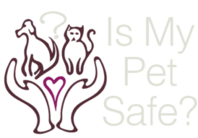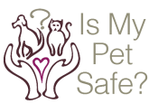Helping Blind Animals
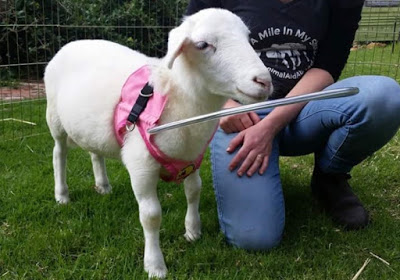
Credit: Possom Valley Animal Sanctuary
Animals with handicaps face a more challenging situation than their human counterparts who often have a wide network of support from friends, family and various charities and government agencies. What little financial and medical aid that is available can be spread so thin that most receive no help at all. The vision-impaired are particularly hard hit as corrective surgery, if possible, can cost many thousands of dollars. The perception of blind animals being poor pets that require significant assistance often results in their placement at the top of shelter kill lists. Yet, the vision-impaired or blind animal can be a good pet and with a little human assistance, they can lead a fairly normal life.
Background
There are many causes of vision impairment in animals, ranging from diabetes and cataracts to sudden acquired retinal degeneration syndrome (SARDS). When the onset of blindness is slow, or at least predictable, the pet can adapt to the loss of vision. If pet parents minimize obstacles and keep furniture and similar objects in fixed locations, a blind pet can often successfully navigate much of their home.
This "mapping" of the familiar takes place over a period of time and is a learning process. A pet that is gradually going blind will develop a memory of the location of obstacles and will use non-visual cues to assist, such as a transition from a carpet to a tiled kitchen floor.
If blindness has happened suddenly or the pet is moved to a new home, this transition can be significantly more difficult but far from impossible. By confining them to a relatively small and safe area, the mapping process can begin (again). Pet parents can add non-visual cues, such as runners on wood floors, and gradually expand the permitted territory to include new unmapped areas. Tactile cues also are very important and can require some creative thinking on the part of pet parents. For instance, mulch or gravel in a the yard can indicate the start of a boundary to a pet.
Animals, like blind humans, also come to rely more upon their other senses such as hearing and smell. Bells and other jingling things can provide sufficient cueing for a pet to follow. The careful application of scents can be used to signify a food dish, door, bed or crate. Many pet toys make noise when they move and provide enjoyment similar to that of other toys a pet may have played with while they had normal vision.
It may also be necessary to do some remedial obedience training if your blind dog will be walked outside of your own yard. The heel command is essential in keeping the dog close by so directional indications can be properly conveyed through pressure on a lead. "Stop" is another critical command for avoiding collisions as are "step up" and "step down" when encountering curbs or other low obstacles.
What more can be done?
Even in the best case, a pet can still have difficulty navigating in and around their home. Bumping into tables and chairs, and especially walls, can and will happen. Is there anything else a pet parent can try?
Indeed there is. Two US based companies each have created devices that can be worn by a blind animal to help them better navigate their surroundings. The basic look of both designs is very similar to the old style, single bar face masks used by football players.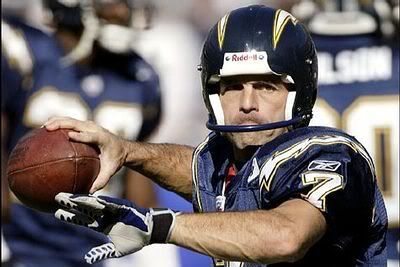 The bar serves two purposes - to keep the head safe during most collisions and to provide tactile feedback to the animal when walls, chairs, fences or any other object is encountered. Both companies began as a result of personal efforts made to help their own blind pet dog; I recently spoke to the heads of each.
The bar serves two purposes - to keep the head safe during most collisions and to provide tactile feedback to the animal when walls, chairs, fences or any other object is encountered. Both companies began as a result of personal efforts made to help their own blind pet dog; I recently spoke to the heads of each.
Halos for Paws
Halos for Paws is the result of Dorie Stratton rescuing an abandoned blind Scottish terrier. After researching how to care for blind and handicapped dogs, Dorie had an idea that she thought would be a significant improvement on existing blind dog collars. Wanting a second opinion, she spoke with her friend Ellen Burgess who previously cared for a blind dog, since deceased. Ellen also had extensive experience designing costumes for a major theme park. In a short while, their joint effort created the first version of the halo vest for Scotty Boy.
The motivation for turning their single vest into a business came after a visit with a veterinary ophthalmologist in Atlanta. After seeing the halo vest in use and convinced it could fulfill a significant need and give blind dogs a better life, the ophthalmologist urged Dorie and Ellen to start a business and make their vest available to other owners of blind pets.
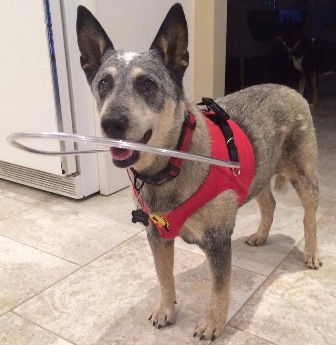
Credit: Halos For Paws
Taking advantage of Ellen's costume design work allows all Halos For Paws vests to be custom made for each pet. A video and diagram on the website explain how and where to take the necessary measurements. Dorie believes that properly sizing the vest is critical to not just a comfortable to wear garment but also one that will stay in place and properly balance the halo.
The vest is similar to some dog harnesses and closes first with Velcro attachment points and then with a traditional snap buckle over the dog's back. There is a D-ring on the top of the vest to make it easy to attach a leash.
The halo is a flexible aluminum wire inside of a plastic tube that inserts into the sides of the vest, just behind the scapula and towards the first few ribs. Dorie explained that the halo is designed to be flexible enough to allow the pet parent to fine tune its position for optimum protection. When engaged by an object, the halo transmits the signal along the tubing and into the sleeves of the vest.
The Halo For Paws vest has been well received by pet parents. While the US is their primary market, Halo For Paws has strong sales to Australia, the UK and Canada. Two of their more notable Australian clients are sheep and the lede photo is of Pearl (you can read some of Pearl's story at the Possum Valley Sanctuary blog and that of another sheep called "64" at ABC news.)
Dorie and Ellen have been approached to provide halo vests to a number of other non-traditional blind animals and as long as the body proportions are similar to a dog's, they have tried to help. Halo For Paws has also made vests upon request for a number of blind cats. Dorie suggests cat owners first be sure their charge will wear a vest without too much fuss and then contact Halo For Pets to see if a custom halo vest can be made. Even so, Halos For Paws considers their primary focus to be helping blind dogs.
Muffin's Halo
IMPS also spoke with Silvie Bordeaux, the creator/founder of "Muffin's My Blind Dog Halo" guide for blind dogs. Like Dorie and Ellen, Muffin's Halo was a project that came from Silvie's desire to provide a better life for her own blind dog, Muffin.
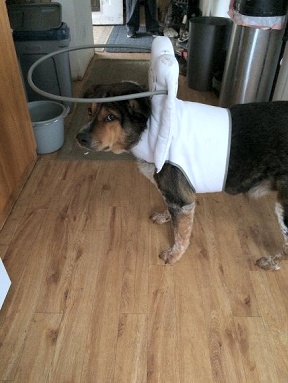
Credit: muffinshalo.com
Muffin's Halo shares similar design principles with the Halo For Paws vest - both have a vest like harness and a large circular metal rod "halo" set inside of tubing. Though Muffin's Halo is not custom made, it is offered in a wide range of sizes.
Muffin's Halo takes a unique approach by attaching the halo to a separate padded "wing." The wing has an inverted U-shaped opening and is attached to the vest at the dog's neck, just in front of the scapula area, by Velcro. Per Silvie, the weight of the wing for the medium sized vest is roughly 3 ounces.
The wing causes the halo to be situated higher, in most cases, than that of the Halos for Paws and it is often at the top of the forehead or higher. However, the neck and head structure of dogs vary greatly and in some cases the halo will be at nose level, similar to the Halos For Paws.
I asked Silvie about the wing and the design choices that she made. Her primary reason for using the wing was her desire to provide additional padding to better protect the shoulder areas of those dogs who tend to bump into walls while walking. Silvie also prefers that the halo be positioned higher, at or just above the top of the dog's head.
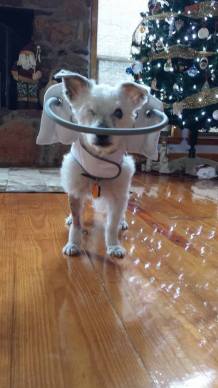
Credit: muffinshalo.com
She also noted that the combination of the wing and a soft vinyl around the halo wire greatly reduces any jolt the pet feels when it inevitably runs into an obstacle.
Another difference is in the style of vest. The Halo For Paws is very traditional and could easily be confused with a standard walking harness were it not for the halo. Muffin's Halo differs in that the vest closes at the front of the dog, around the neckline/top of chest. A D-ring is sewn into the top of the vest to provide a convenient attachment point for a lead.
Silvie noted that with any vest it may take interaction with the environment before the pet realizes that the halo will help them navigate their surroundings. As she put it, "it is almost like an 'ah ha!' moment."
IMPS Analysis
To be clear, IMPS has not physically sampled these vests and the below comments are our educated opinion after speaking with ownership, evaluating the designs and looking at photos and video of both products in use.
Pros:
- Halo For Paws is a minimalist device not requiring much adjustment to use
- Halo For Paws is made to order from custom measurements
- Halo For Paws vest secures with both Velcro and a snap buckle over the back
- Halo For Paws very harness-like vest may be better received by difficult or more active pets
- Halo For Paws already adapted to other pets
- Muffin's Halo wing can detach when pulled
- Muffin's Halo may be more comfortable when sleeping
- Muffin's Halo wing may provide additional upper body protection
- Muffin's Halo provides a gentler signal
Cons
- Halo For Paws halo is not detachable
- Halo For Paws halo may be less comfortable when sleeping
- Halo For Paws may need to be removed when pet parent not home
- Muffin's Halo secures only with Velcro and has no snap buckle
- Muffin's Halo closure around neck may be uncomfortable for some pets
- Muffin's Halo wing may require regular adjustment/reseating
- Muffin's Halo may not provide sufficient feedback for all dogs
- Muffin's Halo wing may be too much to wear for some dogs
The Halo For Paws blind dog halo vest is a simple device that fulfills its objectives well. The addition of a strap with buckle is a great safety feature and makes us feel much more comfortable about using the D-ring to attach a lead and take a pet on a walk outside. Should the pet become spooked, pet parents can have confidence that the vest will remain securely in place. The Muffin's Halo lacks the additional buckle and this makes us feel less confident in outdoor use in a higher traffic or less confined area. Of course, pet parents know their pets best and if a dog is docile and not prone to pulling on the lead, lack of a buckle may not be an issue.
Unlike the Muffin's Halo, there is a safety concern with the Halo For Paws as its halo can get stuck in or caught on an object. Dorie recommends that pet parents using the Halo For Paws not leave the vest on when the pet is home alone unless it is in a room that has been previously cleared of any objects the halo might get caught or stuck on. Silvie notes the Muffin's Halo wing can detach when the pet pulls with sufficient force, thus freeing it from an obstacle. Pet parents will need to consider both their work schedules as well as home environment to determine how much a factor a fixed or detachable halo is when evaluating which of the vests to purchase.
While Muffin's Halo does come in a wide range of sizes, there are some small gaps in dimensions and from the order page, it appears that only one measurement is actually used to select the proper sized vest. Halo For Paws is custom made, so as long as the pet parent has measured accurately, it should have a very good fit. However, both vests give enough flexibility in closure to accommodate small mismatches in sizing.
After watching a number of videos, I worry that the wing on the Muffin's Halo may be prone to movement and thus require readjustments, possibly more often than some owners may wish. Movement may also be a concern if the dog will spend time alone at home with the halo vest on. The Halo For Paws, being more minimalist, does not look prone to this type of problem. However, if your dog is not very active or will be indoors in a fairly well mapped environment, the Muffin's Halo may be fine for your pet.
Finally, on the issue of where the halo attaches. There are three points to this - too high vs. too low, signal vs. shock, and comfort while sleeping. As noted earlier, the Muffin's Halo locates the halo a bit higher than the Halo For Paws. In some cases, we thought it was a bit too high. The converse is true for the Halo For Paws. Is one significantly better than the other? For most dogs, probably not. However, if the vest were to get some slack in it or the wing to lean forward, the lower placed halo may get in the way a bit less than one that starts higher and subsequently dips down over the snout.
Silvie told me she feels the halo on Muffin's Halo transmits less shock to the pet than the side of vest mounted halo used in the Halos for Paws. I would agree that the pet may feel less sensation when running into an object. However, in the side mounted case, the vest itself should flex and absorb much of any shock. Short of hitting an obstacle at a full run, I'm not sure I would be overly concerned but I could be wrong on this. However, I do believe that a case can be made that the halo wing may not always transmit sufficient signal to the pet that can be differentiated from the normal back and forth movement of the wing.
With respect to comfort while sleeping, I would give the edge to the Muffin's Halo but again, I'm not sure this is a big factor. It probably only comes into play on a hard floor or crate and if the pet can maneuver itself to rest on its side without the halo itself getting in the way. If your dog has no qualms about laying on rocks or sticks outside, the choice does not matter. If they will only sleep on your pillow, the Muffin's Halo is probably the better choice.
Conclusion
I think both companies should be commended for bringing to market such helpful devices for blind pets. Either one could make a substantial difference in the quality of life of a blind dog, cat or even a sheep. From a safety perspective, I have small concerns with both, but nothing to discourage the use of either. As with any product, pet parents should always be aware of functional limitations and tailor use and activity appropriately.
Pressed to select one over the other, IMPS would suggest the Halo For Paws, primarily because it is the simpler of the two designs, appears sturdy and is not likely to require adjustments after the initial fitting. It should wear very similarly to the walking harness that so many dogs are already familiar and comfortable which should minimize any chance of rejection by the pet.
Of Note
Silvie asked IMPS to also mention her 501(c)3 not-for profit organization Second Chances For Blind Dogs that helps get halo vests to rescue pets in need.
Dorie and Ellen have put together a very nice page "Living with a Blind Dog" that should be of great help to any pet parents who have a pet that is vision impaired or blind.
IMPS would like to thank both Silvie Bordeaux and Dorie Stratton for taking the time to speak over the phone about their halo vests and also for providing permission to use the included photos.
